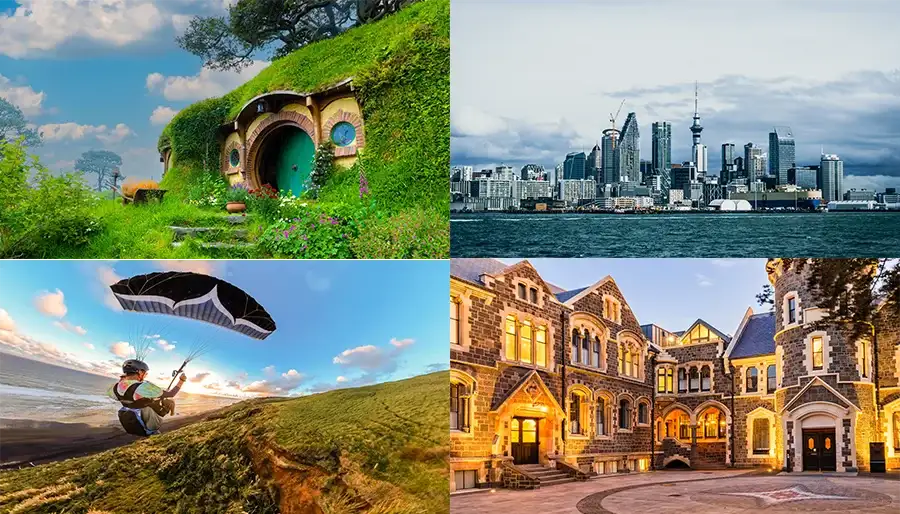
Are you an Indian traveller dreaming of exploring the breathtaking landscapes and unique experiences New Zealand has to offer? Choosing the best time to visit New Zealand is crucial for making the most of your trip. From seasonal weather patterns to festive events and outdoor activities, various factors influence the ideal time for your New Zealand adventure. In this article, we'll guide you through the seasons and help you determine the best time to visit New Zealand, tailored to your preferences.
Key Highlights
New Zealand experiences four distinct seasons, each offering unique attractions and activities for Indian travellers.
The summer months (December to February) are popular for outdoor adventures, beaches, and festivals.
Autumn (March to May) showcases stunning foliage colours and offers mild weather for hiking and sightseeing.
Winter (June to August) is ideal for skiing, snowboarding, and enjoying winter wonderland landscapes.
Spring (September to November) brings new life, blooming gardens, and excellent opportunities for wildlife spotting.
Best Season to Go to New Zealand
Check out the different seasons of New Zealand and where to visit in each -
Summer (December to February)
If you're seeking warm weather and outdoor adventures, the summer months are the best months to visit New Zealand. Indian travellers can enjoy:
Long & sunny days perfect for beach activities, swimming, and water sports.
Popular festivals like New Year's Eve celebrations and the Rhythm and Vines music festival.
Exploring national parks, hiking trails, and scenic drives.
Keep in mind that summer is peak tourist season, so book accommodations and activities in advance.
Also Read -
Make your travel safe. Here are some ways how.
Autumn (March to May)
Autumn offers a stunning display of vibrant foliage colors, making it the best time to go to NZ. Indian travellers can:
Witness the changing leaves in parks and gardens across the country.
Enjoy mild weather ideal for hiking, sightseeing, and outdoor photography.
Attend events like the Hokitika Wildfoods Festival and the Warbirds Over Wanaka airshow.
Autumn is an excellent time to explore New Zealand's landscapes with fewer crowds compared to summer.
Winter (June to August)
Winter transforms New Zealand into a snowy wonderland, attracting ski and snowboard enthusiasts. Indian travellers can:
Hit the slopes at renowned ski resorts like Queenstown and Wanaka.
Experience unique winter activities like heli-skiing, ice skating, and glacier hiking.
Attend the Queenstown Winter Festival, featuring live music, fireworks, and winter sports.
While winters are cold, the snow-capped mountains and crisp air create a magical atmosphere.
Spring (September to November)
Spring brings new life to New Zealand, with blooming gardens, newborn wildlife, and comfortable temperatures. Indian travellers can:
Witness the stunning lupins in bloom at Lake Tekapo and Mount Cook National Park.
Spot newborn lambs and calves in the countryside.
Attend the New Zealand International Film Festival and the World of Wearable Art show.
Spring offers a delightful mix of mild weather, fewer crowds, and vibrant natural beauty.
Also Read -
Here are some useful tips to carry money when travelling abroad
Regional Variations
New Zealand's North and South Islands experience slight variations in climate and attractions:
The North Island has milder temperatures and is known for its beaches, geothermal wonders, and Maori culture.
The South Island is cooler and boasts stunning fjords, glaciers, and adventure sports.
Consider your desired activities and regional highlights when planning your trip.
Cheapest Time to Visit New Zealand
Travelling during the shoulder months (April-May and September-November) can offer benefits for Indian travellers:
Lower airfares and accommodation rates compared to peak season.
Fewer crowds at popular attractions and hiking trails.
Pleasant weather for outdoor activities and sightseeing.
Keep an eye out for shoulder season deals and discounts to save on your New Zealand trip.
Also Read -
Check out the cheapest European countries from India
Festivals and Events
New Zealand hosts numerous festivals and events throughout the year that Indian travellers can enjoy:
Season |
Event |
Location |
Summer | New Year's Eve Celebrations | Nationwide |
Summer | Rhythm and Vines Music Festival | Gisborne |
Autumn | Hokitika Wildfoods Festival | Hokitika |
Winter | Queenstown Winter Festival | Queenstown |
Spring | World of Wearable Art Show | Wellington |
Plan your trip around these events for an immersive cultural experience.
Choose the Best Time for Your New Zealand Adventure
Now that you have a comprehensive understanding of when to visit New Zealand, you can plan your dream trip with confidence. Consider purchasing
travel insurance from reputable companies like Reliance General Insurance to protect your trip investment and ensure a worry-free experience.
FAQs
Q1 - What is the best season to visit New Zealand for skiing and snowboarding?
The winter months (June to August) are ideal for skiing and snowboarding in New Zealand, with the best snow conditions at popular ski resorts like Queenstown and Wanaka.
Q2 - When is the best time to visit New Zealand on a budget?
Travelling during the shoulder months (April-May and September-November) can offer lower prices on airfares and accommodations, making it an excellent time for budget-conscious Indian travellers.
Q3 - What is the best time to visit New Zealand for hiking and outdoor activities?
The summer months (December to February) and autumn (March to May) are great for hiking and outdoor activities, with warm weather and stunning landscapes.
Q4 - Is it necessary to purchase travel insurance when visiting New Zealand?
While not mandatory, purchasing travel insurance from a reliable provider like Reliance General Insurance is highly recommended to safeguard your trip investment and cover unexpected emergencies.
Q5 - What is the best time to visit New Zealand to witness the lupins in bloom?
Spring (September to November) is the best time to visit New Zealand to see the stunning lupins in bloom, particularly at Lake Tekapo and Mount Cook National Park.